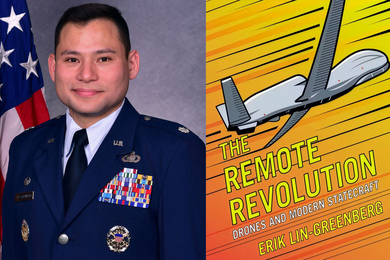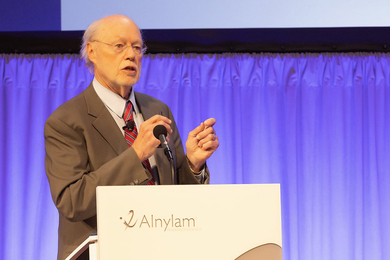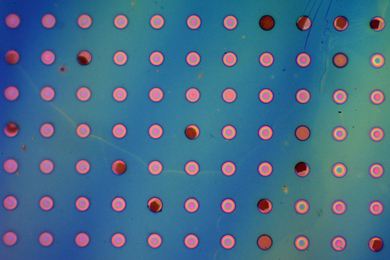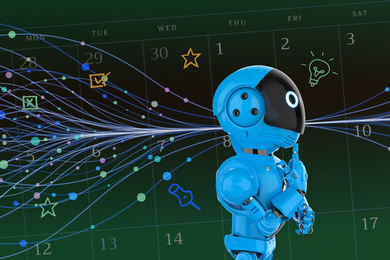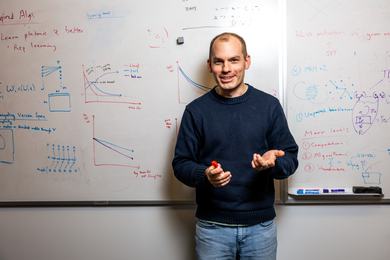Last week's successful space shuttle Discovery mission represented an historic space venture that, like the Apollo 11 mission in 1969, had an MIT astronaut on board a flight that was made possible by MIT advances.
In 1969, NASA's Apollo 11 mission to the moon had astronaut Edwin E. (Buzz) Aldrin Jr. (MIT '63) on board a mission made possible by the inertial guidance system developed by the late Institute Professor Charles Stark Draper.
Last week, astronaut Janice Voss (SB '77, ScD '87) made her second space flight on a cooperative American-Russian mission whose origins can be traced to the 1993 NASA Advisory Committee on the Redesign of the Space Station, chaired by MIT President Charles M. Vest.
This mission represented the first cooperative manned spaceflight between the two countries since the Apollo Soyuz mission in July1975 and the first since the end of the Cold War.
Discovery's primary objective was to conduct a rendezvous with the Russian space station Mir. This tested the systems and procedures that will be used later this year when Atlantis performs the first docking with the Mir in June.
Discovery's crew successfully completed an approach to within 37 feet of the Mir on February 6, despite a fuel leak problem that led to a shutdown of a reactor control system thruster-a backup system in the rendezvous operation. This required a waiver to mission rules, which was agreed to in delicate negotiations carried out between NASA and the Russian Space Agency in the final hours before the two 100-ton spacecraft met in Earth orbit.
The crew also included Air Force Lt. Colonel Eileen M. Collins, who became the first woman space shuttle pilot; Dr. Bernard A. Harris, who became the first African-American to walk in space, and Colonel Vladimir Titov, the second Russian cosmonaut to fly on a US space mission and a veteran of more than one year in space aboard the Mir.
This mission had its origins in the June 1993 Vest Committee report, which recommended "that NASA and the Administration further pursue opportunities for cooperation with the Russians as a means to enhance the capability of the station, reduce cost, provide alternative access to the station and increase research opportunities."
President Clinton endorsed the Vest Committee's recommendations and asked NASA to consider possible Russian involvement and participation in the International Space Station program.
In December 1993, NASA and the Russian Space Agency agreed to conduct a series of joint missions between the space shuttle and the Mir space station as a precursor to US and Russian cooperation in the development of the International Space Station, scheduled to begin assembly in late 1997. The goals of these missions are to gain valuable experience to reduce the technical risks associated with the space station construction, provide early opportunities for extended scientific research in space and demonstrate joint mission procedures.
Discovery's flight was the first in phase one of the new cooperative program. It will be followed by seven Shuttle/Mir docking flights in 1995-97, which will include crew exchanges that will give US astronauts opportunities for long-duration spaceflights aboard the Mir.
Next month, Dr. Norman E. Thagard is due to become the first US astronaut to be launched aboard a Russian Soyuz spacecraft to Mir for a 90 day mission that will conclude with his return on the space shuttle Atlantis when it docks with Mir in June.
In addition, extensive technological and scientific research will be conducted on board the Mir space station, including the Spektr and Priroda modules equipped with US experiments which will be launched later this year.
In October, Atlantis will make its second docking with Mir in order to install a permanent docking module. This mission will be commanded by Marine Corps Col. Kenneth D. Cameron, who received SB and SM degrees in aeronautics and astronautics from MIT in 1978 and 1979.
(John Tylko, SB '79 in aeronautics and astronautics, is a special correspondent for MIT Tech Talk and the chief operating officer of GCC Technologies Inc.)
A version of this article appeared in MIT Tech Talk on February 15, 1995.
